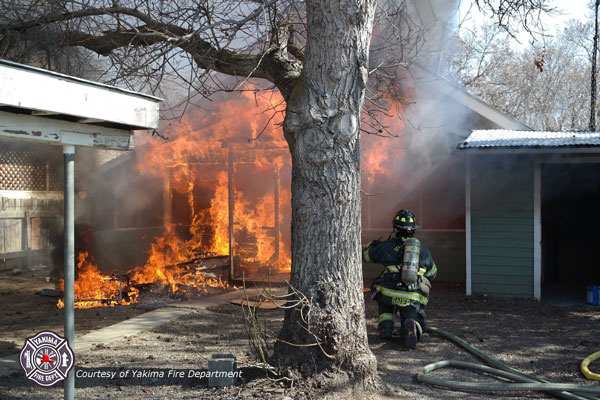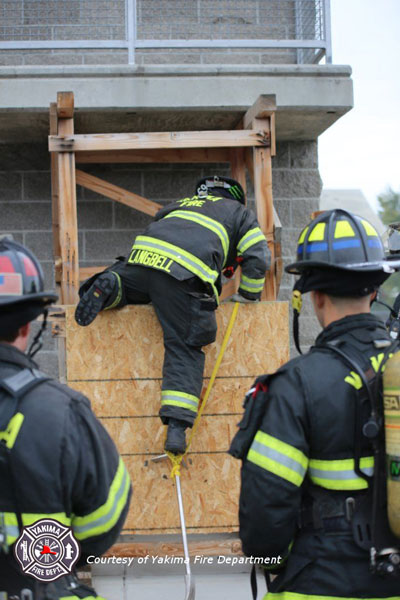
By Alex Langbell
I was two years off of probation and I was certain I knew everything there was to know about fighting fire. So when my engine showed up first on scene of a residential structure with the entire front of the house fully involved, the battalion chief (BC) on scene told us to get water on the fire, and I questioned his orders. I was met by a mob of people who were practically pulling me off of the pumper, telling me there was a guy trapped in a bedroom in the back of the house. Like a good soldier, I followed my officer’s orders and pulled a preconnect, hitting the fire with 200 gallons per minute. In the meantime, I was thinking I need to get this fire out so I can get in and rescue this guy. Looking back, I realize that the BC made a call that slowed the fire enough for a second crew to make a quick rescue, pulling the victim out to safety. That was 18 years ago, and it was the first time I witnessed a vent-enter-search (VES) as we know it today.
VES is a technique of rapidly searching an area mostly likely to have a victim trapped either because his egress is cut off due to fire or because he has difficulty exiting a structure due to mobility issues. The technique is as follows:
- First on-scene crews identify the need for VES. Factors include either report of victim or a good indication victims can be found in uninvolved area of the structure. The main egress of structure could be cut off because of heavy fire conditions.
- The crew selects the appropriate tools, including: hand tools, roof hook (pike pole/rubbish hook), thermal imaging camera, and ladder, if necessary.
- The crew clears a window, removing all glass and obstacles including: bars, window screens, drapes, and blinds. On second-story windows, crews can use the ladder to break out the window, but must watch for falling glass.
- The crew sweeps and sounds the floor below the interior window, sill checking for victims and floor stability.
- The crew places hook into the structure leaning out the window. This allows for several things:
It tells exterior crews that VES is going on in that room; it allows for the crews interior to identify the exit by looking low below the smoke to identify the hook; and it allows for firefighters to use their hands and (walk) down the handle to access rooms with higher window sills without falling into the room.
- Interior crew member(s) makes their way to the open door and closes it, checking for fire conditions outside the room prior to closing.
- An exterior crew member positions themselves outside the window, staying in constant communication with interior crew member(s). This firefighter should be using a thermal imaging camera scanning the room for victims, watching the progress of the crew member(s), and monitoring heat and smoke conditions. The exterior firefighter should be in contact with the incident commander to request assistance if necessary.
- If a victim is found, a second firefighter is sent in to assist with removal of victim.
- The firefighter at the window prepares to receive the victim along with exiting firefighters.
Things to think about
- When setting up the ladder, make sure you set it up for rescue as opposed to the traditional 75 degrees.
- Anticipate finding a victim and have a plan to remove the victim.
- Close all doors to the room that might be adjoining other rooms, including bathroom doors.
- During victim removal, think about protecting the victim from broken glass by using items available such as drapes, blankets, clothing, etc.
- Call for another crew once a victim is located, along with EMS, to assist with patient removal and care.

Practice Makes Perfect
Practice setting up the ladder for second story VES. Practice deploying a ladder and tools quickly, and then getting on air. Some techniques show breaking the window out with a ladder. We prefer to set the ladder up underneath the sill so we can get on air and do a controlled break/ventilation of the window. It can be difficult to break out a modern day double-pane insulated window with a ladder, so don’t spend a lot of time on it if you can’t get it your first couple tries.
Practice getting into and descending into ground level rooms with high window sills. Start looking around your area and you will notice a lot of residential windows where the bottom of the window sill is over four feet high. Have a plan on how to gain access. Using a tool to step on is a practical way in, but make sure you have one once you are inside. Adding a hose strap to the tool and keeping the end of the strap in your hand while you enter will allow you to pull the tool inside with you.
Practice dragging/carrying real civilians. We practice dragging our own all the time, which in some ways is easier with self-contained breathing apparatus. Practice carrying/dragging a victim in blackout conditions. Whether you use some sort of drag device, you must be able to secure it to your victim while wearing gloves, and with no visibility.
Practice removing the victim through the window. Once you have the victim to the window, practice how your crew will get them up to the window sill and either out the window or into the hands of the firefighter on the ladder, and coming down the ladder with a victim.
*
VES is a quick, single-room search and rescue technique we can use to search for and remove victims that can’t get out. This doesn’t replace our traditional method of search and rescue, but allows us to target specific areas once a scenario presents itself. It’s a very simple concept, but if you don’t practice the basics in blackout conditions, you and your crew will struggle.
Alex Langbell is a lieutenant with the Yakima (WA) Fire Department.
MORE TRAINING BULLETINS
- Commercial Search Training Drill: Finding Lost Firefighters
- Training Bulletin: Alley Firefighting
-
Firefighter Training Bulletin: Size-Up
- Firefighter Training Bulletin: Electric Vehicles
- Firefighter Training Bulletin: Flashover
- Fighting Fires in Old Homes
RELATED VES TRAINING
- Oriented Vent-Enter-Search for Small Departments
- Firefighter Training Drill: Vent, Enter, Isolate, Search (VEIS )
- VEIS , a Tactic for Today’s Fires
- Using Vent-Enter-Isolate-Search Tactics
- Realistic Vent-Enter-Search Training
- Roundtable: Vent-Enter-Search on the Fireground
- SEARCH
- Outside Vent Firefighter: A Critical Role

